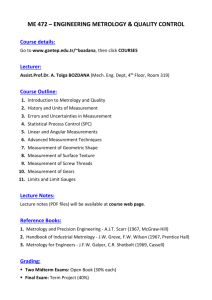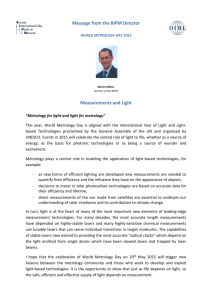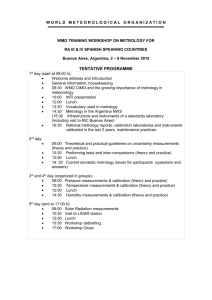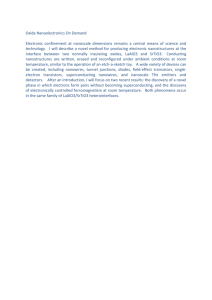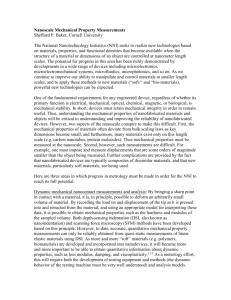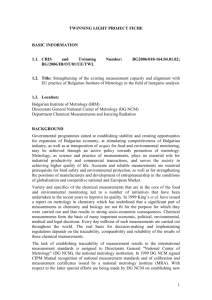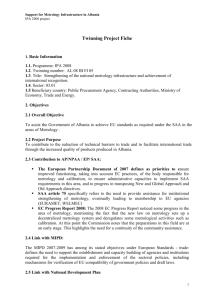Instrumentation and Metrology Strategies for Nanofabrication
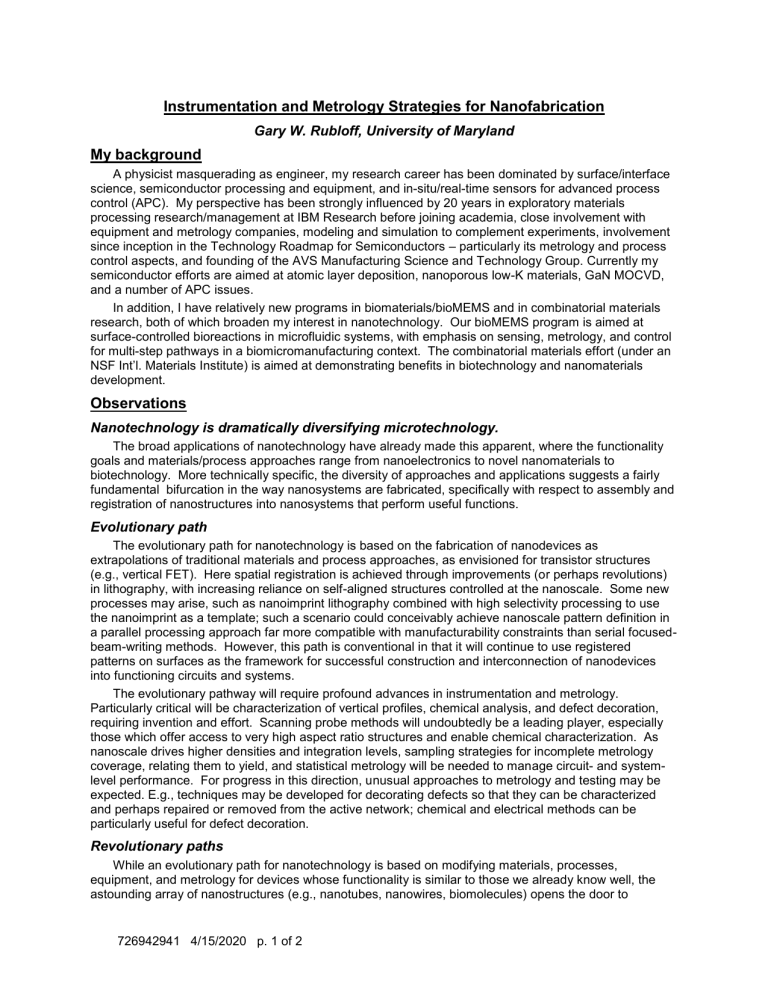
Instrumentation and Metrology Strategies for Nanofabrication
Gary W. Rubloff, University of Maryland
My background
A physicist masquerading as engineer, my research career has been dominated by surface/interface science, semiconductor processing and equipment, and in-situ/real-time sensors for advanced process control (APC). My perspective has been strongly influenced by 20 years in exploratory materials processing research/management at IBM Research before joining academia, close involvement with equipment and metrology companies, modeling and simulation to complement experiments, involvement since inception in the Technology Roadmap for Semiconductors – particularly its metrology and process control aspects, and founding of the AVS Manufacturing Science and Technology Group. Currently my semiconductor efforts are aimed at atomic layer deposition, nanoporous low-K materials, GaN MOCVD, and a number of APC issues.
In addition, I have relatively new programs in biomaterials/bioMEMS and in combinatorial materials research, both of which broaden my interest in nanotechnology. Our bioMEMS program is aimed at surface-controlled bioreactions in microfluidic systems, with emphasis on sensing, metrology, and control for multi-step pathways in a biomicromanufacturing context. The combinatorial materials effort (under an
NSF Int’l. Materials Institute) is aimed at demonstrating benefits in biotechnology and nanomaterials development.
Observations
Nanotechnology is dramatically diversifying microtechnology.
The broad applications of nanotechnology have already made this apparent, where the functionality goals and materials/process approaches range from nanoelectronics to novel nanomaterials to biotechnology. More technically specific, the diversity of approaches and applications suggests a fairly fundamental bifurcation in the way nanosystems are fabricated, specifically with respect to assembly and registration of nanostructures into nanosystems that perform useful functions.
Evolutionary path
The evolutionary path for nanotechnology is based on the fabrication of nanodevices as extrapolations of traditional materials and process approaches, as envisioned for transistor structures
(e.g., vertical FET). Here spatial registration is achieved through improvements (or perhaps revolutions) in lithography, with increasing reliance on self-aligned structures controlled at the nanoscale. Some new processes may arise, such as nanoimprint lithography combined with high selectivity processing to use the nanoimprint as a template; such a scenario could conceivably achieve nanoscale pattern definition in a parallel processing approach far more compatible with manufacturability constraints than serial focusedbeam-writing methods. However, this path is conventional in that it will continue to use registered patterns on surfaces as the framework for successful construction and interconnection of nanodevices into functioning circuits and systems.
The evolutionary pathway will require profound advances in instrumentation and metrology.
Particularly critical will be characterization of vertical profiles, chemical analysis, and defect decoration, requiring invention and effort. Scanning probe methods will undoubtedly be a leading player, especially those which offer access to very high aspect ratio structures and enable chemical characterization. As nanoscale drives higher densities and integration levels, sampling strategies for incomplete metrology coverage, relating them to yield, and statistical metrology will be needed to manage circuit- and systemlevel performance. For progress in this direction, unusual approaches to metrology and testing may be expected. E.g., techniques may be developed for decorating defects so that they can be characterized and perhaps repaired or removed from the active network; chemical and electrical methods can be particularly useful for defect decoration.
Revolutionary paths
While an evolutionary path for nanotechnology is based on modifying materials, processes, equipment, and metrology for devices whose functionality is similar to those we already know well, the astounding array of nanostructures (e.g., nanotubes, nanowires, biomolecules) opens the door to
726942941 4/15/2020 p. 1 of 2
strikingly different scenarios for fabricating nanosystems, with applications from next-era computation to ubiquitous chemical and biological sensing. What distinguishes these scenarios from evolutionary pathways is not simply the presence of fundamentally different nanostructure elements, but radically different schemes for assembling functional systems from these elements.
Assembly must be accomplished at both nanoscale and in relation to micro/macro scale. Selforganizing nanostructure elements (e.g., regular arrays of nanopore structures in thin film materials, or randomly distributed carbon nanotubes with well-defined nanostructure) are helpful, but assembly of components into useful functioning entities remains unknown territory. As another bifurcation, one can envision two scenarios for assembly of nanostructures. If the active nanostructure elements are selfassembled by reference to a template (e.g., 3-D assembly as regular arrays of nanopores), then their assembly into circuits/systems presents what may be a nano-interconnect challenge. On the other hand, if the active nanostructure elements are not self-assembled, it is necessary to either custom-connect them
(given their randomized position and orientation), or else to transport, register, and align them as free objects. The latter situation may be amenable to microfluidic environments, where fluid flow and/or electrokinetic effects provide potential degrees of freedom for remote guided assembly. And development along these lines is already being driven by opportunities in biotechnology.
Schemes to deal with complex arrays of nanostructures, whether tethered to surfaces or freely movable in fluids, demand sensing, actuation, and control systems driven by metrology. This in turn places a premium on the development of integrated scanning probes which are able to manage the assembly and/or interconnecting of nanostructures. Super-selective processes (e.g., biomolecule-based attachment) could be a key enabler for intelligent immobilization of nanostructures where they need to be in order to assemble working circuits/systems. And as with evolutionary paths to nanofabrication, defect decoration, sampling strategies, and statistical metrology may be critical metrology needs.
10-year Future for Nanometrology
These possibilities suggest an R&D emphasis on key advancements for both evolutionary and revolutionary approaches. Here are some long-term research goals to consider:
Development of embedded scanning probes and/or other test sites within MEMS environments would enable sensing, characterization, metrology, actuation, and control
Development of multilevel microfluidics, without and with active on-board microactuator control, would substantially broaden design capabilities
Understanding and demonstration of biomolecular conjugation would make possible superselective attachment and assembly of various nanostructures (both biological and nanobased inorganic)
Strategies for defect decoration (chemical, electrical, etc.), metrological sampling in vast arrays of nanostructures, and on-site repair (e.g., fuse-blowing) could substantially improve scale-up to functional nanosystems
Identification and demonstration of approaches for microfluidic and electrokinetic based directed assembly of nanospecies would confirm viability of fluidics-based assembly of free nanostructural elements
Understanding of what constitutes an efficient hierarchy for nanosystems assembly would clarify how nanoscale structures, nanoscale registration/connections, and microscale/macroscale inputs/outputs should be related to each other for system efficiency
726942941 4/15/2020 p. 2 of 2
